Miele TDB120WP Review
Miele TDB120WP Review
Not the cheapest tumble dryer, but one of the best
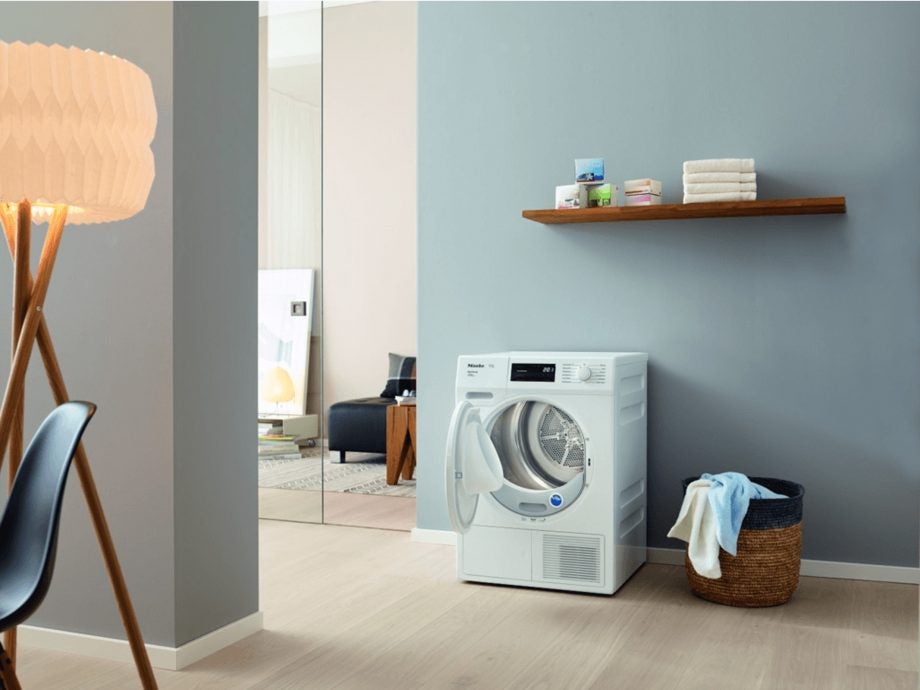
Verdict
Pros
- Perfect drying results
- Very easy to use
- Outstanding build quality
- Good with small loads
- Plumbed waste option
- Fragrancing works well
Cons
- Not as efficient as some
- Short of features
Key Specifications
- Review Price: £799.00
- 7kg capacity
- Heat-pump technology
- A++ energy rating
- Sensor drying
- FragranceDos
- Gentle Tumble
- Drum light
What is the Miele TDB120WP?
Cracking a whole new, more affordable price range for Miele, the A++ energy-rated TDB120WP tumble dryer comes in at under £800. It uses heat-pump technology, has Fragrance Dos capsules to perfume your wash, and is built just as robustly as Miele’s more expensive products.
Impeccable drying results across four dryness levels, fuss-free ease of use, and that innovative perfuming system add up to a great machine. Drum size and energy efficiency are not at the top of their game at this price, but there’s no faulting the Miele’s overall outstanding performance.
Related: Best tumble dryers
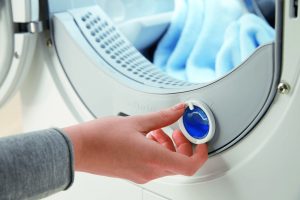
Miele TDB120WP – Design and features
The TDB120WP is an interesting design. At first it would be easy to say that it isn’t breaking too many moulds aesthetically. Yet look closely and there’s plenty of design flair, plus Miele’s signature attention to detail.
This heat-pump tumbler is stoically square in stance, with a business-like selector knob and purposeful lines. The water container cover swoops down below the door line, giving a bigger area to grasp, and the door’s bold handle is in the upper-right quadrant to make it easier to open.
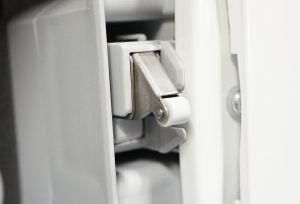
The huge vent below the door maximises its grille area for more efficient air flow. The concealed condenser flap beside it pushes to open on one of Miele’s trademark metal catches. That has the sort of build quality and positive feel that suggests it will outlast the machine, you and possibly the planet.
Behind the flap, the lower filter pulls out with ease on possibly the largest handle to ever grace a tumble dryer condenser filter. If the next Bond movie needs a scene removing the core from a small nuclear device, this mechanism will probably suffice. The foam filter behind pops off the frame for easy cleaning.
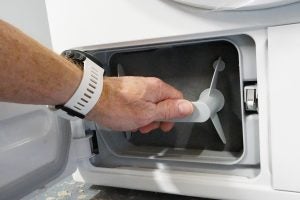
Around the back, a flexible hose runs from the condenser at the base to the water container at the top. If you have waste plumbing nearby, you can simply pop off the hose and divert it to waste. No need for plumbing skills or additional kits.
There’s not a single button on the fascia, just the programme selector knob. Options, what there are of them, are accessed by touch controls on the display.
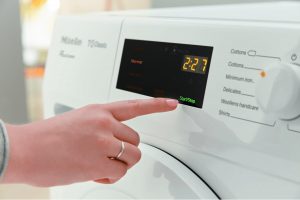
The door pops open remarkably easily to reveal a medium-capacity 7kg tub. This is lit internally by blue-white LEDs that highlight Miele’s ‘gentle on your clothes’ honeycomb-imprinted drum. The lower section of the otherwise enormous porthole is taken up by a two-stage fluff filter. The first stage has a proper handle to aid removal. None of your fiddly pinch-clips here.
The filter frame is also home to Miele’s Fragrance Dos perfume system. Using special perfume capsules, or ‘flacons’ as Miele refers to them, you can fragrance your wash in one of five pleasant whiffs. These include Aqua, Nature, Cocoon, Orient and the only one who’s name gives any indication of its smell, Rose.
A single Aqua flacon is supplied with the machine. In case you were wondering, a ‘flacon’ is a small stoppered bottle traditionally used for perfume.
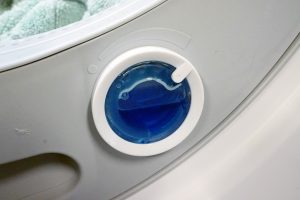
Miele TDB120WP – What’s it like to use?
The TDB120WP is a supremely logical machine to use and features are few enough not to confuse the issue. Miele has clearly trimmed the features count, rather than fundamentally redesign and rebuild to hit the new lower price point.
That said, the TDB120WP is a full-sensor machine with Miele’s PerfectDry system that measures air moisture and calculates drying time automatically. You simply select the required programme and choose one of four drying levels by touching the relevant text on the bold, vacuum fluorescent display.
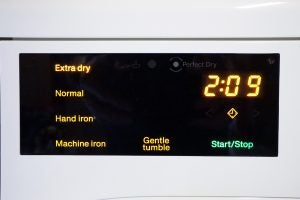
The touch controls are large enough not to miss and are nicely responsive too. The display shows time remaining (re-calculated after a few minutes of sensing) and indicator lights for water container full, the lower filter needing cleaning and the PerfectDry system working.
Drying levels are labelled Extra Dry, Normal, Hand Iron and Machine Iron. We have no idea what the difference between a hand iron and a machine iron is, but the machine iron level is slightly damper of the two.
Other controls include a Delay Start, Gentle Tumble for delicate clothes and the Start button. No, really, that is it for controls and features.
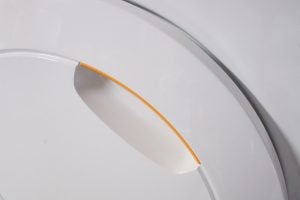
The water container is large enough to see you through a few drying loads and pulls out easily to empty. The in-door fluff filter will need cleaning each load. This pulls out equally easily to clean. The second part of the filter can remain in situ for a wipe over with your fingers or a damp cloth.
One area where we would recommend having a quick squint at the manual is when first using the fragrance flacons.
Fitting the flacon to the machine and rotating the capsule to control the strength of the fragrance is easy enough. Removing the seal from a new flacon is the challenge. It requires holding the capsule in a certain orientation or very strong fragrance liquid spills all over your hands, jeans and trainers. I still smell very sweet walking around the lab.
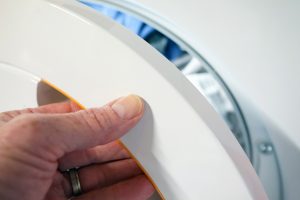
Miele TDB120WP – How noisy is it?
OK, the TDB120WP isn’t the quietest tumbler in Miele’s range. It has a regular tumble-rumble motor sound for the duration of its operation. That is followed by a regular crease-prevention tumble every couple of minutes after the cycle has ended.
The energy label states a rather rumbustious 66dB. While we did get the odd peak in sound pressure approaching this level, the average is a more ear-friendly 61-62dB. That is around the same volume as normal conversation. It’s nothing like the 70dB of older generation tumble dryers but there are plenty of quieter models out there.
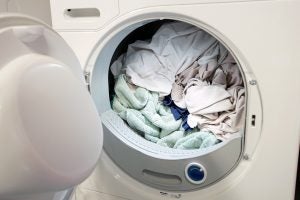
Miele TDB120WP – What programmes does it have?
The TDB120WP is a 12-programme tumble dryer. Options include four drying levels and a gentle tumble mode. And, well, that’s it. This model is designed to be simple to use, and Miele has achieved just that.
Heading up the programme listing is the Cottons ‘Eco’ programme, denoted by the left-facing blocky arrow. This symbol is probably derived from the shape of the arrows on the original energy labels. Whatever its origins, it indicates the most economical cycle on the appliance.
Below that is the standard Cottons programme. This is a few minutes quicker than Cotton Eco. Both take the maximum 7kg (dry weight) load.
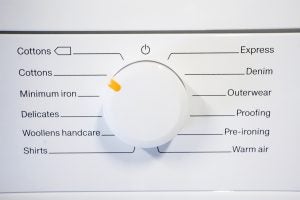
The Minimum Iron programme is a 4kg load cycle designed for wash and wear clothes such as workwear, socks and underwear. Delicates, Wool, Shirts and Outerwear specific programmes handle up to a 2.5kg load while you can put in 3kg on the Denim cycle. The Express Dry programme is a shorter, warmer Cottons programme for up to 4kg of drying in a hurry.
For drying moder fabrics such as microfibre and ski clothes, you get the Proofing cycle. For technical fabrics that need reproofing occasionally this programme also doubles as the seal-in phase for new proofing. We assume they don’t mean wax cotton jackets as that could get messy…
The Pre Ironing cycle is designed to quickly remove the bulk of moisture from a small 1kg load. Clothes will emerge quite damp so will be easiest to iron. The Warm Air cycle is a freshen-up programme for dry clothes. Both these programmes allow you to get the nasal benefits of the FrangranceDos system into your clothes.
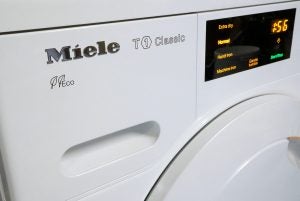
Miele TDB120WP – How well does it perform?
We started off with our regular 80% of maximum load, or 5.6kg of mixed cottons. This included t-shirts, tea towels, shirts, sheets and towels fresh from a 1600spin. We started with the standard Cottons programme set to Normal Dry.
At start-up the cycle time indicated 2 hours 12 minutes, although this dropped to 1 hour 40 minutes after the PerfectDry system had done its calculations. It did its calculations well too.
At the end of the cycle we both agreed we’d class the load as nicely normal dry/cupboard dry. There was just a little moisture left to stop serious creasing, but not so much you wouldn’t want to put the clothes straight into the cupboard. PerfectDry indeed.
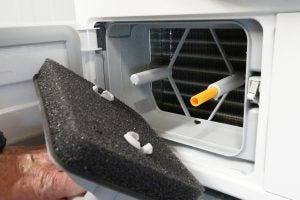
This cycle used 1.2kWh of electricity. We re-washed exactly the same load and ran the drying again, this time on Cotton Eco. Time initially said 2 hours 30 minutes and dropped to 1 hour 50 minutes after calculating the moisture. Again, the result was a perfect cupboard dry finish. Energy used? 0.97kWh. Not exactly a huge saving but worthwhile over the course of a year.
Halving the load to 40% or 2.8kg saw equally spot-on cupboard dry results with energy dropping to between 0.7 and 0.8kWh for Cotton Eco and Cotton normal. That is a solid reduction in power for a smaller load.
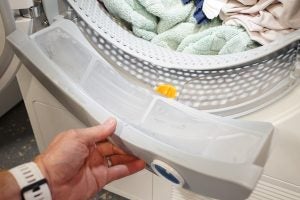
Over the course of two weeks we tested various loads on the other dry settings. There didn’t seem to be a massive difference between the results of Machine Iron and Hand Iron dry. However, the scales indicated there was around 50g (1%) more moisture remaining in a 5.6kg load with the Machine Iron level selected.
Somewhat predictably from Miele, the TDB120WP does exactly what its sets out to do, and does it well. Dryness levels were faultless, run-times reasonable and the energy consumption not too bad at all. The PerfectDry system is very good at detecting smaller loads and that will definitely reduce running costs for those who like to dry in smaller batches.
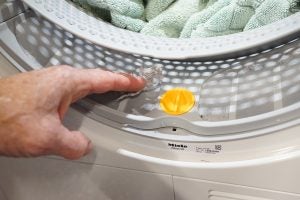
Miele TDB120WP – How much will it cost to run?
Compared to old-style, heater-element condenser dryers, Miele’s TDB120WP will use a fraction of the electricity to dry the same size of load. Yet by the standards of top-spec (A+++) tumble dryers, including Miele’s own models, running costs are a little higher than the very best in class at this price.
If you used this machine 150 times per year at 100 full loads (80% or 5.6kg to replicate real-world use) and 50 small loads up to 2.8kg, using the Cottons Eco programme it would use around 132kWh per year (100 x 0.97kWh + 50 x 0.7kWh). At an average 15p/kWh, that comes in at below £20 for a years’ worth of drying.
That is not too shoddy and represents perhaps a third of the running costs of an older condenser model. Yet the slightly smaller than average 7kg drum does mean the cost per kg of clothing dried is only average among heat-pump dryers at this price level.
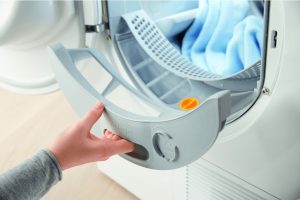
Why buy the Miele TDB120WP?
The TDB120WP is a relatively affordable offering from the Miele brand. It combines basic features, ease of use and energy efficiency in a very well-built package. Drying to a selected level was faultless, and the PerfectDry sensor system is one of the most accurate we’ve tried. Running costs are a smidgen higher than from some heat-pump tumblers at this price, but only by a few pounds per year. The useful dip in running costs for light loads will suit smaller families and the Fragrance Dos system works well.
If you’re looking for a long-lasting heat-pump dryer without all the bells and whistles, Miele has nailed it with the TDB120WP.
Verdict
Not the cheapest heat-pump dryer, but the TDB120WP’s build, ease of use and perfect drying results make it heartily recommended.
Trusted Score
Other
| Power Consumption (KWh) | 0.97kWh |
| Cost Per Load at 15p/KWh | 10p |
| Remaining Moisture (Grams / % of load) | 2% |
| Time to Completion | 1hour 40mins |
| Max Noise | 62dB |
| Cupboard Dry Accuracy | Perfect |
General Info
| Drum Capacity | 7kg |
| Energy Rating | A++ |
| Approx. Annual Power Consumption (KWh) | 132kWh |
| Approx. Annual Running Cost | £19.80 |
50% Mixed Dry Load / 'Cupboard Dry'
| Power Used (KWh) | 0.7kWh |
| Running Cost per Load at (15p/KWh) | 7pence |
| Moisture Remaining (Grams / % of load) | 2% |
| 'Cupboard Dry' Accuracy | Perfect |
| Time to Finish | 1hr 4mins |
| Noise Max Spin | 62dB |


